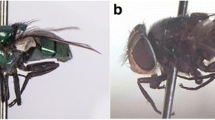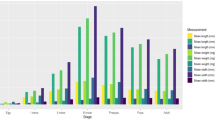Abstract
The larval morphology and developmental rate of Chrysomya megacephala (F.) and Chrysomya rufifacies (Macquart), the two most forensically important blowfly species in Thailand, are presented. Morphological comparison of the third instar of both species revealed different characteristics (e.g., body appearance, cephalopharyngeal skeleton, dorsal cuticular spines between the prothorax and mesothorax, and feature of the posterior spiracle), thereby, allowing correct identification. A data analysis was conducted in Chiang Mai province, Northern Thailand during 2000–2001 on the developmental rate of both flies under natural ambient temperature and a natural light–dark photoperiod. The results indicated that larvae of C. megacephala developed more rapidly in April, pupariation initiated at 84 h at temperatures averaging 31.4°C, and the larvae grew slower in the rainy season and winter. Similarly, rapid development of C. rufifacies larvae appeared in the summer, with a pupariation period as short as 96 h in June (average temperature 27.4°C). Analysis of the median body length of C. megacephala and C. rufifacies larvae in different seasons of the years 2000–2001 in Thailand revealed that both species developed rapidly in the summer; pupariation of C. rufifacies initiated at 144 h, while C. megacephala initiated pupariation at 156 h. This information is potentially useful for estimating the postmortem interval of a corpse in forensic investigations, where the corpse becomes infesting with these fly species.





Similar content being viewed by others
References
Ames C, Turner B (2003) Low temperature episodes in development of blowflies: implications for postmortem interval estimation. Med Vet Entomol 17:178–186
Anderson GS (1997) The use of insects to determine time of decapitation: a case-study from British Columbia. J Forensic Sci 42:947–950
Anderson GS (2000) Minimum and maximum development rates of some forensically important Calliphoridae (Diptera). J Forensic Sci 45:824–832
Barreto M, Burbano ME, Barreto P (2002) Flies (Calliphoridae, Muscidae) and beetles (Silphidae) from human cadavers in Cali, Colombia. Mem Inst Oswaldo Cruz 97:137–138
Butler GD, Lopez JD (1980) Trichogramma pretiosum: development in relation to constant and fluctuating temperatures. Ann Entomol Soc Am 73:671–673
Byrd JH, Allen JC (2001) The development of the black blow fly, Phormia regina (Meigen). Forensic Sci Int 120:79–88
Byrd JH, Butler JF (1997) Effects of temperature on Chrysomya rufifacies (Diptera:Calliphoridae) development. J Med Entomol 34:353–358
Byrd JH, Castner JL (2001) Insects of forensic importance. In: Byrd JH, Castner JL (eds) Forensic Entomology: the Utility of Arthropods in Legal Investigations. CRC, Florida, pp 43–79
Champlain RA, Butler GD (1967) Temperature effects on the development of the eggs and nymphal stages of Lygus hesperus (Hemiptera: Miridae). Ann Entomol Soc Am 60:519–521
Dadour IR, Cook DF, Fissioli JN, Bailey WJ (2001) Forensic entomology: application, education and research in Western Australia. Forensic Sci Int 120:48–52
Davies L, Ratcliffe GG (1994) Developmental rates of some pre-adult stages in blowflies with reference to low temperature. Med Vet Entomol 8:245–254
Goff ML (2000) A Fly for the Prosecution: How Insect Evidence Helps Solve Crimes. Harvard University Press, Cambridge, p 225
Goff ML, Flynn MM (1991) Determination of postmortem interval by arthropod succession: a case study from the Hawaiian Islands. J Forensic Sci 36:607–614
Goff ML, Odom CB (1987) Forensic entomology in the Hawaiian Islands. Three case studies. Am J Forensic Med Pathol 8:45–50
Goff ML, Omori AI, Gunatilake K (1988) Estimation of postmortem interval by arthropod succession. Three case studies from the Hawaiian Islands. Am J Forensic Med Pathol 9:220–225
Grassberger M, Reiter C (2002) Effect of temperature on development of the forensically important holarctic blow fly Protophormia terraenovae (Robineau-Desvoidy) (Diptera: Calliphoridae). Forensic Sci Int 128:177–182
Grassberger M, Reiter C (2001) Effect of temperature on Lucilia sericata (Diptera: Calliphoridae) development with special reference to the isomegalen- and isomorphen-diagram. Forensic Sci Int 120:32–36
Greenberg B, Tantawi TI (1993) Different developmental strategies in two boreal blow flies (Diptera: Calliphoridae). J Med Entomol 30:481–484
Greenberg B, Wells JD (1998) Forensic use of Megaselia abdita and M. scalaris (Phoridae: Diptera): case studies, development rates, and egg structure. J Med Entomol 35:205–209
Gunatilake K, Goff ML (1989) Detection of organophosphate poisoning in a putrefying body by analyzing arthropod larvae. J Forensic Sci 34:714–716
Hagstrum DW, Leach CE (1972) Role of constant and fluctuation temperatures in determining developmental time and fecundity of three species of stored products Coleoptera. Ann Entomol Soc Am 66:407–410
Haskell NH (1990) Procedures in the entomology laboratory. In: Catts EP, Haskell NH (eds) Entomology and Death: A Procedural Guide. Joyce's, Clemson, pp 111–123
Ishijima H (1967) Revision of the third stage larvae of synanthropic flies of Japan (Diptera: Anthomyiidae, Muscidae, Calliphoridae and Sarcophagidae). Jpn J Sanit Zool 18:47–100
Jenson LM, Miller RH (2001) Estimating filth fly (Diptera: Calliphoridae) development in carrion in Guam. Micronesica 34:11–25
Lee HL, Krishnasamy M, Abdullah AG, Jeffery J (2004) Review of forensically important entomological specimens in the period of 1972–2002. Trop Biomed 21:69–75
Lefebvre F, Pasquerault T (2004) Temperature-dependent development of Ophyra aenescens (Wiedemann, 1830) and Ophyra capensis (Wiedemann, 1818) (Diptera, Muscidae). Forensic Sci Int 139:75–79
Liu D, Greenberg B (1989) Immature stage of some flies of forensic importance. Ann Entomol Soc Am 82:80–93
Lord WD (1990) Case histories of the use of insects in investigations. In: Catts EP, Haskell NH (eds) Entomology and Death: A Procedural Guide. Joyce's, Clemson, pp 9–37
Lord WD, Goff ML, Adkins TR, Haskell NH (1994) The black soldier fly Hermetia illucens (Diptera: Stratiomyidae) as a potential measure of human postmortem interval: observations and case histories. J Forensic Sci 39:215–222
Mankosol R (1986) Estimation time of dead in putrefied body. Siriraj Hosp Gaz 38:855–857
Marchenko MI (2001) Medicolegal relevance of cadaver entomofauna for the determination of the time of death. Forensic Sci Int 120:89–109
Mascarini LM, Prado AP (2002) Thermal constant of an experimental population of Muscina stabulan (Fallén 1817) (Diptera: Muscidae) in the laboratory. Mem Inst Oswaldo Cruz 97:281–283
Musvasva E, Williams KA, Muller WJ, Villet MH (2001) Preliminary observations on the effects of hydrocortisone and sodium methohexital on development of Sarcophaga (Curranea) tibialis Macquart (Diptera: Sarcophagidae), and implications for estimating postmortem interval. Forensic Sci Int 120:37–41
Nabity PD, Higley LG, Heng-Moss TM (2007) Light-induced variability in development of forensically important blow fly Phormia regina (Diptera: Calliphoridae). J Med Entomol 44:351–358
Queiroz MM (1996) Temperature requirements of Chrysomya albiceps (Wiedemann, 1819) (Diptera, Calliphoridae) under laboratory conditions. Mem Inst Oswaldo Cruz 91:785–788
Richards EN, Goff ML (1997) Arthropod succession on exposed carrion in three contrasting tropical habitats on Hawaii Island, Hawaii. J Med Entomol 34:328–339
Richardson MS, Goff ML (2001) Effects of temperature and intraspecific interaction on the development of Dermestes maculatus (Coleoptera: Dermestidae). J Med Entomol 38:347–351
Smith KGV (1986) A Manual of Forensic Entomology. Cornell University Press, Ithaca, NY
Sukontason K, Narongchai P, Kanchai C, Vichairat K, Sribanditmongkol P, Bhoopat T, Kurahashi H, Chockjamsai M, Piangjai S, Bunchu N, Vongvivach S, Samai W, Chaiwong T, Methanitikorn R, Ngern-klun R, Sripakdee D, Boonsriwong W, Siriwattanarungsee S, Srimuangwong C, Hanterdsith B, Chaiwan K, Srisuwan C, Upakut S, Moopayak K, Vogtsberger RC, Olson JK, Sukontason KL (2007) Forensic entomology cases in Thailand: a review of cases from 2000 to 2006. Parasitol Res 101:1417–1423
Sukontason KL, Narongchai P, Sukontason K, Methanitikorn R, Piangjai S (2005) Forensically important fly maggots in a floating corpse: the first case report in Thailand. J Med Assoc Thai 88:1458–1461
Sukontason KL, Sukontason K, Narongchai P, Lertthamnongtham S, Piangjai S, Olson JK (2001) Chrysomya rufifacies (Macquart) as a forensically-important fly species in Thailand: a case report. J Vector Ecol 26:162–164
Wells JD, Kurahashi H (1994) Chrysomya megacephala (Fabricius) (Diptera: Calliphoridae) developmental: rate, variation and implications for forensic entomology. Jpn J Sanit Zool 45:303–309
Acknowledgements
This work was supported by the Thailand Research Fund (RMU4980007). We thank the Faculty of Medicine and Chiang Mai University for defraying the publication cost.
Author information
Authors and Affiliations
Corresponding author
Additional information
This work has been presented at the 21st Pacific Science Congress held in Okinawa, Japan, in 12–18 June, 2007.
Rights and permissions
About this article
Cite this article
Sukontason, K., Piangjai, S., Siriwattanarungsee, S. et al. Morphology and developmental rate of blowflies Chrysomya megacephala and Chrysomya rufifacies in Thailand: application in forensic entomology. Parasitol Res 102, 1207–1216 (2008). https://doi.org/10.1007/s00436-008-0895-6
Received:
Accepted:
Published:
Issue Date:
DOI: https://doi.org/10.1007/s00436-008-0895-6




